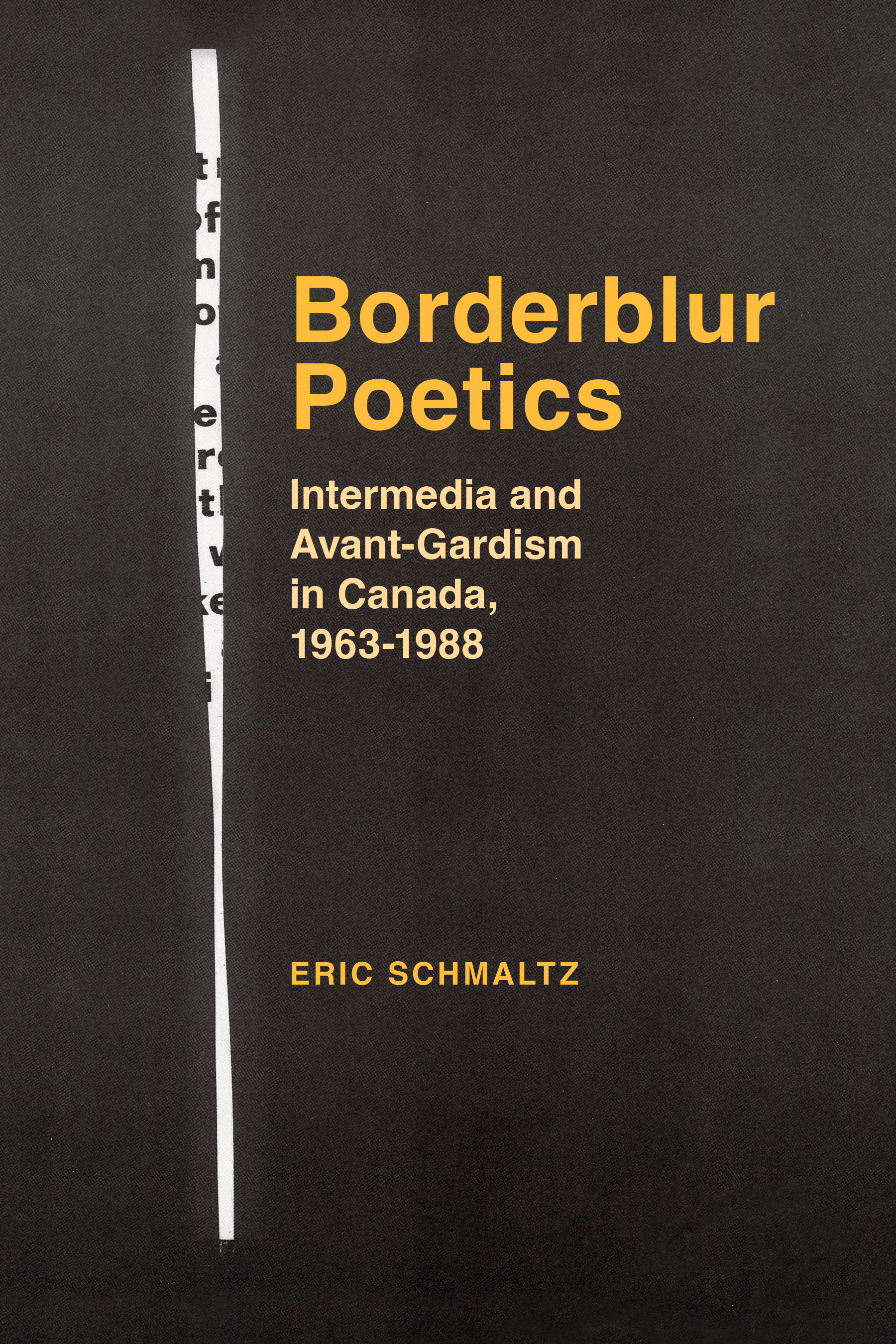
Borderblur Poetics: Intermedia and Avant-Gardism in Canada, 1963-1988
Eric Schmaltz
$74.99 HC / $39.99 PB (S)
279 pages
6 x 9 inches
Hardback: 978-1-77385-456-4
Paperback: 978-1-77385-457-1
Epub: 978-1-77385-460-1
Library PDF: 978-1-77385-459-5
August 2023
Discover how avant-garde artists challenged the cultural hegemony with intermedial forms of literary production in this exciting examination of Canada’s borderblur poets.
Beginning in 1963 and continuing through the late 1980s, a loose coterie of like-minded Canadian poets challenged the conventions of writing and poetic meaning by fusing their practice with strategies from visual art, sound art, sculpture, installation, and performance. They called it “borderblur.”
Borderblur Poetics traces the emergence and proliferation of this node of poetic activity, an avant-garde movement comprising concrete poetry, sound poetry, and kinetic poetry, practiced by poets and artists like bpNichol, bill bissett, Judith Copithorne, Steve McCaffery, Penn Kemp, Ann Rosenberg, Gerry Shikatani, Shaunt Basmajian, among others.
Author Eric Schmaltz demonstrates how these poets formed an alternative tradition, one that embraced intermediality to challenge the hegemony of Canadian literature established during the heydays of cultural nationalism. He shows the importance of intermediality as a driving cultural force and how its proliferation significantly altered Canadian cultural expression. Drawing on a combination of archival research, historical analysis, and literary criticism, Borderblur Poetics adds significant nuance to theories and criticisms of Canadian literature.
Eric Schmaltz is Writer-on-the-Grounds in the Department of English at York University’s Glendon College. He is the author of the poetry book Surfaces, editor of Another Order: Selected Works of Judith Copithorne, and co-editor of I Want to Tell You Love: A Critical Edition by bill bissett and Milton Acorn.
Acknowledgements
Epigraph
Introduction
Canons and Controversies: Literary Traditions and Intermediality in Canada
Bordering the Book: Critical Parameters
From Here to There: A Brief Chapter Outline
Bordering the Blur
In Search of Experience: Borderblur Poetics in Canada
Dropping Off the Borders: An International Network of Algernative Poetics
Intermedia Poesis in the Electric Age
“Fuck the Avant-Garde”: Borderblur and Theories of the Avant-Garde
Concrete Poetry
Beginning Again: A Confluence of Encounters
Canadian Concrete Poetry and the Electric Age
Against Manipulation: Advertising and Consumer Culture
Breaking the Typing Machines
(Moving) Images: Film, Television, Photography
Sound Poetry
Questioning the Cadence: Sound, Nation, Affect
A Network of Sonic Affiliations
Language and Sound in the Electronic Age
Affect and Extension: Listening to Canadian Sound Poetry
Kinetic Poetry
Toward a Theory of Kinetic Poetics
Kinetic Art and Literature: Borderblur’s Kinetic Context
Kinetics and Poetics in Canada
Extending the Codex
Games and Puzzles
Immersive and Environmental Works
Intermedia Poetry in Canada Today
Notes
Bibliography
Index
Borderblur Poetics offers a wealth of information about some of the most significant North American poetry and poetics of the late 20th century. Eric Schmaltz provides illuminating socio-historical contexts for a stunning spectrum of unconventional Canadian poetry that averts national narratives while staying tuned to local contexts and the plural event of the poem.
—Charles Bernstein, author of Pitch of Poetry
Borderblur Poetics traces a sensualized paratradition in Canadian literary history in which meaning is made between the body and the word, language and living, the mundane and the transcendent. By documenting this practice within a community of radical experimentation, Schmaltz reveals an underexplored aesthetic aim of inclusivity and connectivity—with one another, with audience, and with the very process of meaning-making.These poets sought out, forged, and revealed openings where hierarchal systems diametrically opposed the expansiveness of borders that blur. Schmaltz’s rigorous study is essential reading for anyone wishing to understand 20th century poetic revolution in Canada and beyond.
—Suzanne Zelazo, writer and critic, co-editor of Body Sweats
Bless Borderblur Poetics for its abundance of obscure ephemeral publications, collected from public and private archives of a paratradition in the field of Canadian Literature, bless its exhumation of this space outside of normative lingual habits and conventions. Blast the normative tradition! Dr. Schmaltz provides a rare critical examination of the radical fringe in the context of its own internal logic. Visual poetry, sound poetry, and kinetic poetry, though folded together as intermedia, are each given room to demonstrate their particular effects. The attention to individual works includes recognition of the importance of their production and the emergence of small and experimental publishing venues in Canada, which are catalogued in detail. The readings are engaging and well-realized, moving energetically through a wide range of subjects. Bless this book! The scholarship is sound and makes an impressive contribution to the field—expanding the terrain of Canadian Literature into the realm of the Avant-Garde—and the field of Avant-Garde literature even further into Canada.
—Gregory Betts, author of Avant-Garde Canadian Literature
Through methodical research and deft close readings, Borderblur Poetics presents a vivid history of Canadian experimental poetry the mid-to-late 20th-century. Schmaltz deepens our understanding of this heady time by tracing the continuities and affiliations between concrete, sound, and kinetic poets. His diverse range of examples conveys the audacity of these iconoclasts who operated in the margins of polite society. Brilliantly situating their work within international aesthetic and theoretical currents, Schmaltz provides a subversive counter-narrative to the received view of Canadian literature as singularly focused on nation building, revealing Canlit’s wilder side. This is an essential resource by one of the field’s most exciting scholars.
—Myra Bloom, literary critic, The Walrus